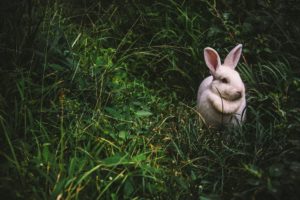Aww, aren’t they cute? Rabbits are just little balls of fluff that you just can’t help but want to hug. Those tiny paws, those small hops, and that tiny face should be all but enough to tell you that rabbits are just one of the best animals ever!
So why is it that this article is here talking about rabbits in a negative light, more specifically, infestations? Is there such a thing as too many rabbits, when you get to have such lovable, fluffy animals in return?
Unfortunately, for as fluffy and nice as rabbits can be, they do indeed present a number of problems that you might not be automatically aware of at first, and in some places, they can even be regarded as pests when they cause trouble, such as infesting places. The biggest thing that people know about rabbits in this regard is that when it comes to reproducing among most animals, they are second to none, probably only beat out by insects that can lay hundreds and hundreds of eggs at a time. Still, the breeding prowess of rabbits is not to be underestimated.
How can it get this far?
As mentioned earlier, rabbits in general might be famous for being cute and cuddly, but wild rabbits are also infamous for their breeding tendencies. Since they are unlikely to be spayed or neutered, this means that they are free to reproduce with one another for as much as they are able to, and believe me, they will reproduce, given an opportunity to. There’s a reason why the term “breeding like rabbits” exists.
But for the more technical details, it goes like this: Rabbits can become pregnant quite early on in their life with some breeds starting their reproductive cycle in as early as 4 months old. Once this cycle starts, they become fertile for practically the entire month, barring 3 days that is. However, rabbits will only produce an egg when mated with by a male rabbit.
Once impregnated, the mother rabbit will be expectant for around a month, and have a litter of young, which can be anywhere from between 6 rabbits to 14!
Not only that, after giving birth, the mother rabbit can become impregnated again almost immediately after, which can be one heck of a cycle of a mother giving birth to a litter of rabbits every month. This can easily spiral out of control if the rabbit population isn’t controlled somewhat.
Rabbit infestations in Australia
If we want to look at the effects of rabbit breeding in countries, we can look no further than the rabbit infestations over at Australia.
Ever since the European rabbits had been introduced to the continent, Australia has grappled with the problem of having too many rabbits to deal with. Today, there are approximately 200 million wild rabbits living around the continent. How did it begin? In 1859, a wealthy settler brought 13 European wild rabbits to Australia so that they could be hunted, and with how fast they can breed and reproduce, it’s no wonder that it took as little as 50 years for their species to reach all parts of the continent. Because of their large numbers, they wreaked havoc on crops and land, and this led to soil erosion. They also had a problem with overgrazing due to their large numbers, which had negative consequences on the agriculture and plants. In addition, as the rabbits themselves are an invasive species, they disrupted the ecological balance of the continent, and led to a decline of native animals and plant species.
These rabbits are really good at adapting to their surroundings and aren’t very picky with their habitats either. Give them soil that they can burrow in and short grass to graze on and they’re set for life, and these conditions aren’t difficult to come by in the continent either.
Attempts by people from government researchers to farmers to mitigate the effects that these rabbits have on the country have been met with different amounts of success, depending on their techniques. Some such techniques involve fences, poisons, and pathogens in an attempt to drive their population down.
Is it really that bad?
This is not to say that you should look at your pet rabbits with scorn the next time you walk into the room with them. It is simply in their own nature and instinct to breed that way and is why neutering and spaying are even a thing in the first place.
It’s not that having rabbits is a bad thing, but it can be dangerous if they are left unchecked and allowed to do whatever on their own. That one wealthy person with 13 rabbits managed to create an ecological disaster for an entire country, and all he did was release a couple of rabbits out into the woodlands. They weren’t even numerous, and at the time, would have been easy pickings for any predators. Unfortunately, because they managed to get away and reproduced, this caused a cascading effect of chain reactions which eventually led to the rabbit problem that Australia has today.
So keep this in mind: rabbits are still the same fluffy creatures but can become a problem if their population is left unchecked. There are more ways that an animal can hurt you than by simply threatening to bite your head off, after all.

